Six ecommerce user experience best practices for your online shop
You know what’s great about today’s ecommerce industry? That anyone can start an online shop with as little as £10. And lots of people are.
The problem with that is that there’s more competition than ever. So, unless you’re selling a one-of-a-kind product, you’re competing against tens or hundreds of local online shops, or thousands if you’re selling internationally.
How do you stand out from the competition? Do you discount your prices? Do you run sales every week? That’s not an effective strategy as you’ll end up losing money in the long run, and you’ll also have a hard time retaining customers.
Fortunately, there’s a better way. It’s called user experience (UX) and it’s the best investment you can make to boost sales and revenue for your online shop.
Why?
Because a great user experience is quickly beginning to trump pricing. Customers are willing to pay more for a shopping experience that’s easy, safe, hassle-free, and pleasant.
So instead of lowering your prices, think about making user experience the key differentiation that sets your ecommerce business apart from the competition.
In this post we’ll explain what user experience is and share the six best practices you can implement on your ecommerce website to boost sales and entice customers to come back to your online shop time and again.
What is user experience?
UX for ecommerce is about creating a simple, logical and enjoyable shopping experience on your online shop that makes customers happy, or at least meets their expectations and doesn’t confuse or frustrate them.
This doesn’t just refer to simply designing an ecommerce site that’s appealing to the eye. The discipline of user experience goes beyond web design.
In fact, it refers to a user’s overall experience from the moment they discover your store to the point they make a purchase, and beyond, when they may be looking for support using or returning an item.
Have you thought about how easy it is to find a specific product on your store? Or how clear your product descriptions are when it comes to size, material, ingredients, or where it’s made? What about how much information you’re asking new customers to share with you to be able to buy something from your store?
That’s user experience and it’s important for three key reasons:
- It builds trust with your target audience.
- It increases your organic rankings since Google rewards fast-loading, easy to navigate sites that users don’t leave in under two seconds.
- It boosts your sales and revenue.
So what can you do to reap these benefits? Let’s look at a few best practices to help you achieve a solid UX on your online shop.
Six ecommerce user experience best practices
1. Provide a clear navigation
Having a great-looking ecommerce website is purposeless if your visitors don’t know how to use it. You don’t want them to click and scroll endlessly to find the product they’re looking for and/or to buy it, do you? Because if they notice it’s taking too long, they’ll simply leave and go to your competitors instead.
To prevent that from happening, you need to think like your customers and structure your website to effectively guide them through your online shop.
Here’s what you need:
- A menu with the main categories of products you’re selling.
- A search bar at the top of every page on your site to make it easy for visitors to quickly find what they’re looking for.
Check out how prominent the search bar is on Asos’ website:

- A sitemap of your website. This is like a roadmap to all the different pages on your site.
If you’re having trouble creating yours, the best way to learn is to go to Amazon and take a closer look at their categories. They’re the largest internet company by revenue, after all.
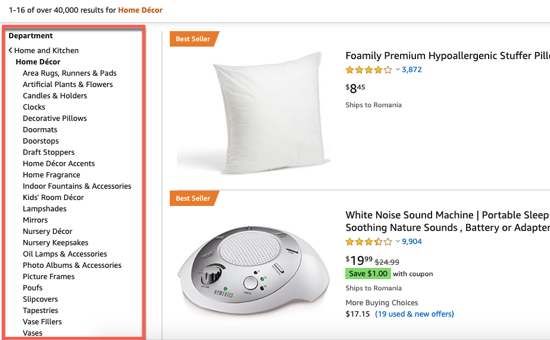
- Breadcrumbs so people know where they are on your site at any given time.
Here’s an example from Bergfreunde.eu that lets you know exactly where you are on the site:
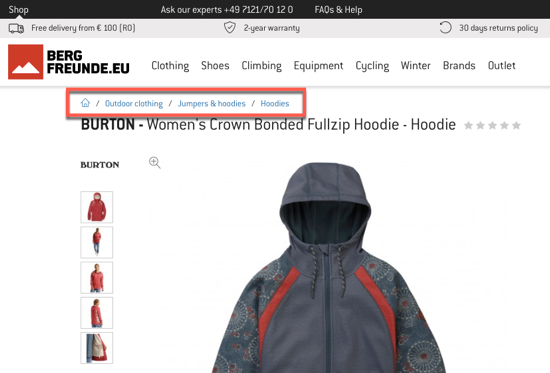
Check out this post to learn more about breadcrumbs best practices.
2. Speed up your website
Your customers are impatient. You probably are too when you shop online. And what do you do when a page takes what seems like forever to load? You leave, correct?
That’s what your customers do, too. So if you want to keep them on your site, browsing and buying from you, you need to speed up your website.
Start by using Google’s PageSpeed Insights to check your site’s speed score. Marks are out of 100 and anything over 90 is ideal, while a score under 80 indicates you have speed issues that need to be addressed. The tool will also make suggestions on what you need to fix in order to make your site faster.
You can also read this post to learn more about why speed matters and how to get up to speed so you don’t lose any more customers to your competitors.
3. Make people feel safe on your site
It’s not uncommon for a prospect to leave an online shop or abandon a checkout process if they distrust it with their personal information or credit card details.
So, what can you do to alleviate trust issues and boost confidence in your website? There are lots of things but the following elements are key:
- Contact information that’s visible in the header and footer of every page on your site. This includes email address, phone number, customer support pages, social media accounts, as well as links to your About and Contact pages.
- A great return policy to reassure prospects that if they don’t like a product for whatever reason, they can send it back for a full refund.
- A SSL certificate that lets visitors know that their shopping experience, including any information they share with you during their visit on your site, is safe and secure. Check out the SSL certificates from 123 Regto learn more about how they work and why they’re essential to securing your site and building consumer trust.
To get a better idea of how these elements would look on an online shop, here’s an example from Bergfreunde.eu’s header:
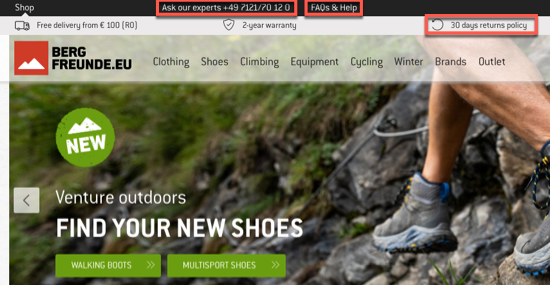
And here’s the information displayed in the footer on every page of their store:
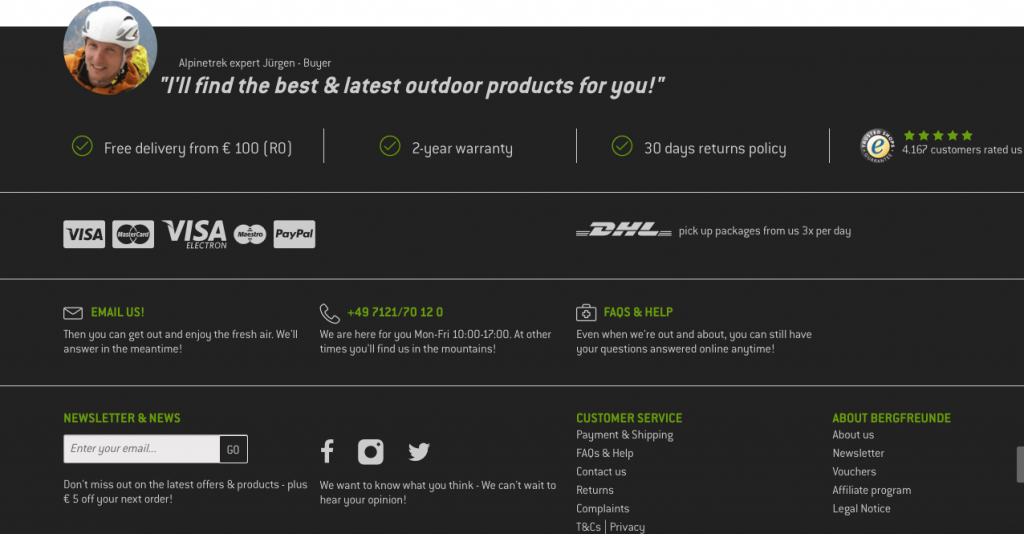
Want more? Read this post to learn about more ways to earn customer trust.
4. Create product pages that convert
Want to turn visitors into paying customers? Then you need to ensure your product pages not only educate customers about the products you sell but also inspires them to click that “Buy now” button.
Here are a few ways to help you achieve that:
- Write compelling descriptions that entices them to buy. This article includes some great tips on how to sell your product in a description.
- Give them all the information they need to make an informed decision. For example, if you’re selling clothes, be specific when it comes to dimensions, size, fabric, colours and more.
- Use large, high-resolution products so users can get a better picture of what they’re getting. Try to avoid stock photos, if you can help it.
- Recommend popular related products to help them find the perfect product faster and get them to complete the purchase.
- Add a prominent call-to-action to guide them to the next step. Here’s how to create a persuasive call-to-action.
For more advice and examples, read our post on how to optimise your product pages to sell more.
5. Make the sign-up and checkout processes fast and simple
Compulsory signups and lengthy checkouts are probably amongst the most frustrating parts of a shopping experience. Precisely because of that you should focus on making them as short, simple and smooth as possible.
Here are some pointers to help make it easier for your customers to pay and, as a result, boost sales:
- Don’t force users to register to be able to buy from your online shop. Give them the option to checkout as guests.
- Simplify the sign-up process by only asking customers for the information you absolutely need. Don’t make them waste their precious time by asking for extra information you’re not planning to use anyway.
- Provide numerous payment methods so they can choose their favourite.
- Use a single-column structure to make the registration process simple.
Here are a few more tips on how to optimise your shopping cart checkout.
6. Be there to help
You have so many options to offer guidance and help to your customers, no matter what your budget is.
For instance, you can add live chat to your online store or, if your resources are limited, you can choose to provide customer support using chatbots or via email or phone.
Here’s an example from 123 Reg where we do our best to give you all the help and support you need to achieve your goals:
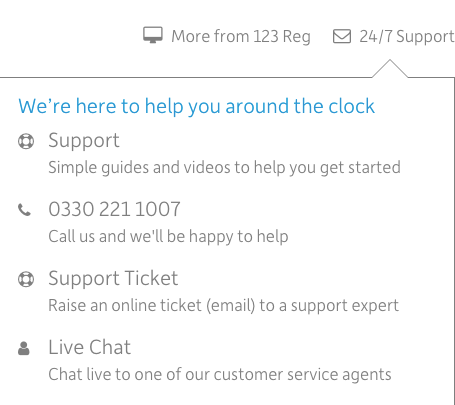
Not sure which option is right for your ecommerce website? Why not test them for a week or a month and see which ones work best for your online shop?
If you need more information, read these two posts to learn more about live chat and chabots. Hopefully they’ll give you a better idea of how they work and how they can positively impact users’ experience on your site and, as a result, your shop’s revenue.
Five reasons why you should add live chat to your online shop
Should your small business use chatbots for customer service?
Wrapping up
User experience is key to your online shop’s success. It helps you to build trust with your prospects, get better visibility in Google’s search results, and increase sales. So make sure you experiment with the above tactics to determine which ones work best for your specific store and target audience.
Our advice? Carry out usability testing to accurately assess how easy it is for your visitors to achieve a particular task (or tasks) on your store.
Don’t know how? We have an in-depth guide that explains what user experience testing is and how to use it to make improvements to your ecommerce website.
You can learn more about how to set up an online shop in this guide.
